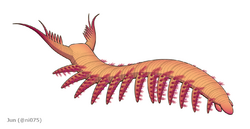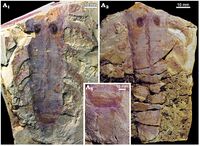Biology:Jianshanopodia
| Jianshanopodia | |
|---|---|

| |
| Reconstruction of Jianshanopodia decora | |
| Scientific classification | |
| Kingdom: | |
| Phylum: | †"Lobopodia"
|
| Class: | †Xenusia
|
| Order: | †Siberiida[1]
|
| Family: | †Siberiidae[1]
|
| Genus: | †Jianshanopodia
|
| Species: | †J. decora
Liu et al., 2006 |
Jianshanopodia is a monotypic genus of Cambrian lobopodian, discovered from Maotianshan Shales of Yunnan, China .[2]
Description
Jianshanopodia resemble the closely-related siberiid Megadictyon. The head possess a pair of frontal, grasping[3] appendages bear wedge-shaped plates. The pharynx was surrounded by rows of denticles, resembles those of radiodonts and priapulids.[4][5] The trunk was annulated and posses a pair of stout legs (lobopods) per body segment. Due to the lack of a complete specimen, the exact number of body segments/leg pair is uncertain. If 12 body segments present, the living animal might grew over 20 cm.[2] Each of the leg was lined up with rows of tubercles and tree-like branches,[2] instead of being tipped with claws as many lobopodians are.[3] The trunk terminated with a large median lobe and a pair of small lateral lobes, forming a fan-like structure.[2] Inside the trunk was a sediment-filled gut surrounded by serially repeated diverticulae.[3][2]
Jianshanopodia was suggested to be mainly crawled on the sea floor, but could swim with its fan-like tail when necessary.[2][3] The leg branches might function as external gills.[2] It is thought to be predatory and have sucked up prey with its short 'trunk',[3] consuming food items with its robust mouthparts and gut diverticulae.[6]
Phylogeny
Phylogenetic position of Jianshanopodia according to Pates et al. (2022).[7]
| ||||||||||||||||||||||||||||||||||||||||||||||||||||||||||||||||||||||||||||||||||||||||||||||||||||
References
- ↑ 1.0 1.1 Dzik, Jerzy (2011). "The xenusian-to-anomalocaridid transition within the lobopodians". Bollettino della Società Paleontologica Italiana 50 (1): 65–74. http://www.paleo.pan.pl/people/Dzik/Publications/Siberion.pdf.
- ↑ 2.0 2.1 2.2 2.3 2.4 2.5 2.6 Jianni Liu; Degan Shu; Jian Han; Zhifei Zhang; Xingliang Zhang (2006). "A large xenusiid lobopod with complex appendages from the Lower Cambrian Chengjiang Lagerstätte". Acta Palaeontologica Polonica 51 (2): 215–222. http://www.app.pan.pl/article/item/app51-215.html. Retrieved 2015-03-13.
- ↑ 3.0 3.1 3.2 3.3 3.4 Liu, J.; Shu, D.; Han, J.; Zhang, Z.; Zhang, X. (2008). "Origin, diversification, and relationships of Cambrian lobopods". Gondwana Research 14 (1–2): 277–283. doi:10.1016/j.gr.2007.10.001. Bibcode: 2008GondR..14..277L.
- ↑ Vannier, Jean; Liu, Jianni; Lerosey-Aubril, Rudy; Vinther, Jakob; Daley, Allison C (2014). "Sophisticated digestive systems in early arthropods". Nature Communications 5: 3641. doi:10.1038/ncomms4641. PMID 24785191. Bibcode: 2014NatCo...5.3641V.
- ↑ Smith; Caron (2015). "Hallucigenia's head and the pharyngeal armature of early ecdysozoans". Nature 523 (7558): 75–8. doi:10.1038/nature14573. PMID 26106857. Bibcode: 2015Natur.523...75S. http://dro.dur.ac.uk/20476/1/20476.pdf.
- ↑ Vannier, Jean; Liu, Jianni; Lerosey-Aubril, Rudy; Vinther, Jakob; Daley, Allison C. (2014-05-02). "Sophisticated digestive systems in early arthropods" (in en). Nature Communications 5 (1): 3641. doi:10.1038/ncomms4641. ISSN 2041-1723. https://www.nature.com/articles/ncomms4641.
- ↑ Pates, Stephen; Wolfe, Joanna M.; Lerosey-Aubril, Rudy; Daley, Allison C.; Ortega-Hernández, Javier (2022-02-09). "New opabiniid diversifies the weirdest wonders of the euarthropod stem group". Proceedings of the Royal Society B: Biological Sciences 289 (1968). doi:10.1098/rspb.2021.2093. PMID 35135344.
Wikidata ☰ Q6191844 entry
 |




